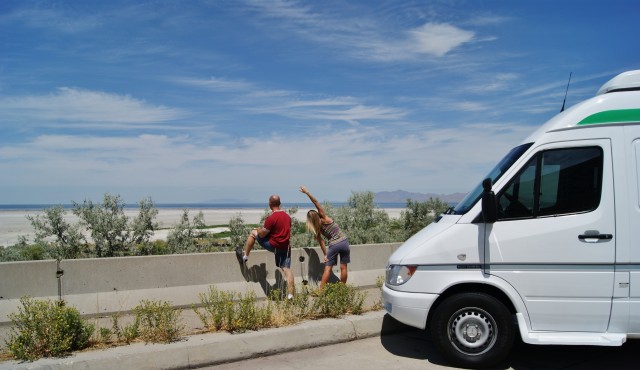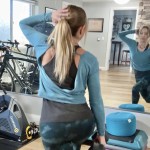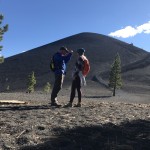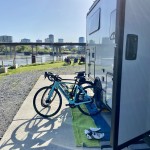This post may contain affiliate links.
You’ve been driving cross country the past 10 hours, quite pleased with yourself because you only had to stop twice so far. You even shaved off 45 minutes from the GPS’s estimated time of arrival. Take that, Tomtom!
You finally arrive at the RV park for the evening, and you step out of the RV. In that moment, your lower back screams with pain. You are so stiff you can barely straighten up. And your head feels like a million spiders have spun their cobwebs around every neuron in that thick head of yours.
Yes, you beat the GPS, good job, Jeff Gordon. But in the process, you completely disregarded your health and set yourself up for what could turn out to be long-term back problems. With a little forethought and attention to your body’s needs on the road, a situation like this can be prevented. Let’s look at things we should be doing to keep our bodies fit and avoid back pain on the road.
1) Get Up.
Too much sitting, whether it be our long driving days or the inviting lawn chairs at our campsites, wreaks havoc on our backs. Set a driving rule that you’ll stop every two hours for 15 minutes. Be active for those 15 minutes…walking around a rest stop or seeing a roadside attraction. Even better, do some of my recommended back exercises for RVers! The same rules apply for those lawnchairs. Never sit for longer than two hours. Your back will most definitely thank you.
2) Proper Posture
Emily Post was right on this one. Whether sitting, walking, or lifting, it is crucial to use good posture to keep your back healthy. If you don’t use good posture, your spine can become fixed in abnormal positions, which causes strain on the body and contributes to back aches and injuries.
Our driving posture is important for our back’s health as well. To maintain a correct driving position, make sure your seat has back support (lumbar roll) at the curve of your back. If it doesn’t, consider purchasing a lumbar roll. Your knees should be at the same level or higher than your hips. Adjust the seat close to the steering wheel so you won’t need to lean forward and your spine stays supported on the back rest. Don’t jut your chin and head forward; make sure they are pulled back.
Here’s a quick test to check your posture. Stand with your back and head against a wall. Have your feet out about six inches from the wall, and your hands touching the wall down at your sides. If you have good posture, there should be less than two inches of space between your neck and the wall, and also between the small of your back and the wall. If there is more than two inches in either area, then that indicates poor posture and a curving spine.
3) Maintain a Healthy Weight.
The spine is designed to carry our body’s weight and distribute the loads it encounters, whether we are active, sitting, or resting. But when we carry excess weight in our stomachs, it pulls our pelvis forward and causes our center of gravity to shift forward. The spine is forced to carry the extra burden, which may lead to structural compromise and injuries. Maintaining a healthy weight will reduce the load on our spine and lessen our chance of back problems.
4) Exercise
You’ve heard this a million times, I’m sure, but I can’t leave this one out of the list. One of the best things you can do for yourself, whether you are on the road or not, is to be physically active. Regular exercise not only can ease your back pain and stiffness, it will also strengthen your bones and muscles, improve your flexibility, increase your energy, help you sleep, boost your mood, and reduce your risk of heart disease and certain cancers. Phew! Exercise truly is the best medicine. Now that I’ve convinced you to get moving, give my latest back exercise video a try! It’s a great way to start incorporating gentle back exercises into your RV travels. Of course, you should know your limits. If your back is so painful that you can hardly imagine exercising, speak to your doctor about appropriate therapeutic exercises. Start slowly, and build from there.
5) Proper Shoes
This one seems so simple, but can make all the difference in keeping our backs healthy. When we wear the wrong shoes, an entire kinetic chain of negative events occurs. Our walking gait is thrown out of whack. We compensate by resetting our posture. Our body rebels since it isn’t used to the new posture. Our back has to work overtime to maintain the new posture, and might even sway unnaturally, which ends up stressing our lumbar erector spinae muscle. Bottom line; be mindful of the shoes you put on when you head out the RV door. It could make or break your day’s adventures.
_____________________________________
So, there you have it. Five tips to keep your back in good health and you in the driver’s seat….but remember, only for two hours, RIGHT?!












Maybe this is a silly question,but what are the proper shoes?
That’s actually a great question. But since we’re all different, it’s not easy to answer. The best way to find out your specific shoe needs would be to have a gait analysis. Many athletic stores offer this to determine your degree of pronation/supination and how your foot strikes the ground when you take a step. The proper shoe for you will correct any abnormalities and will prevent or alleviate any injuries due to compensation. Besides offering support where you need it, the proper shoe will also fit your foot comfortably and be the right size. Hope this helps!